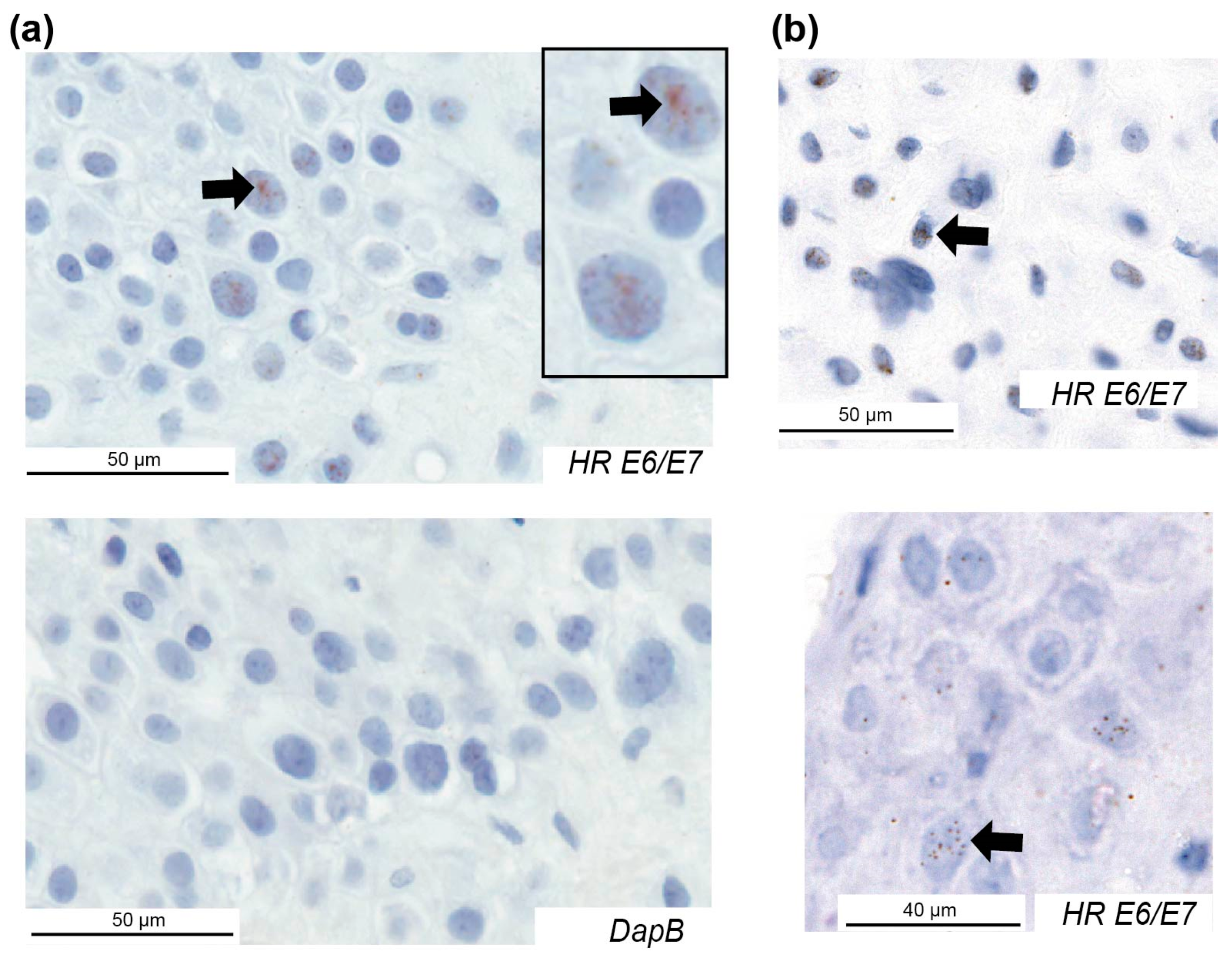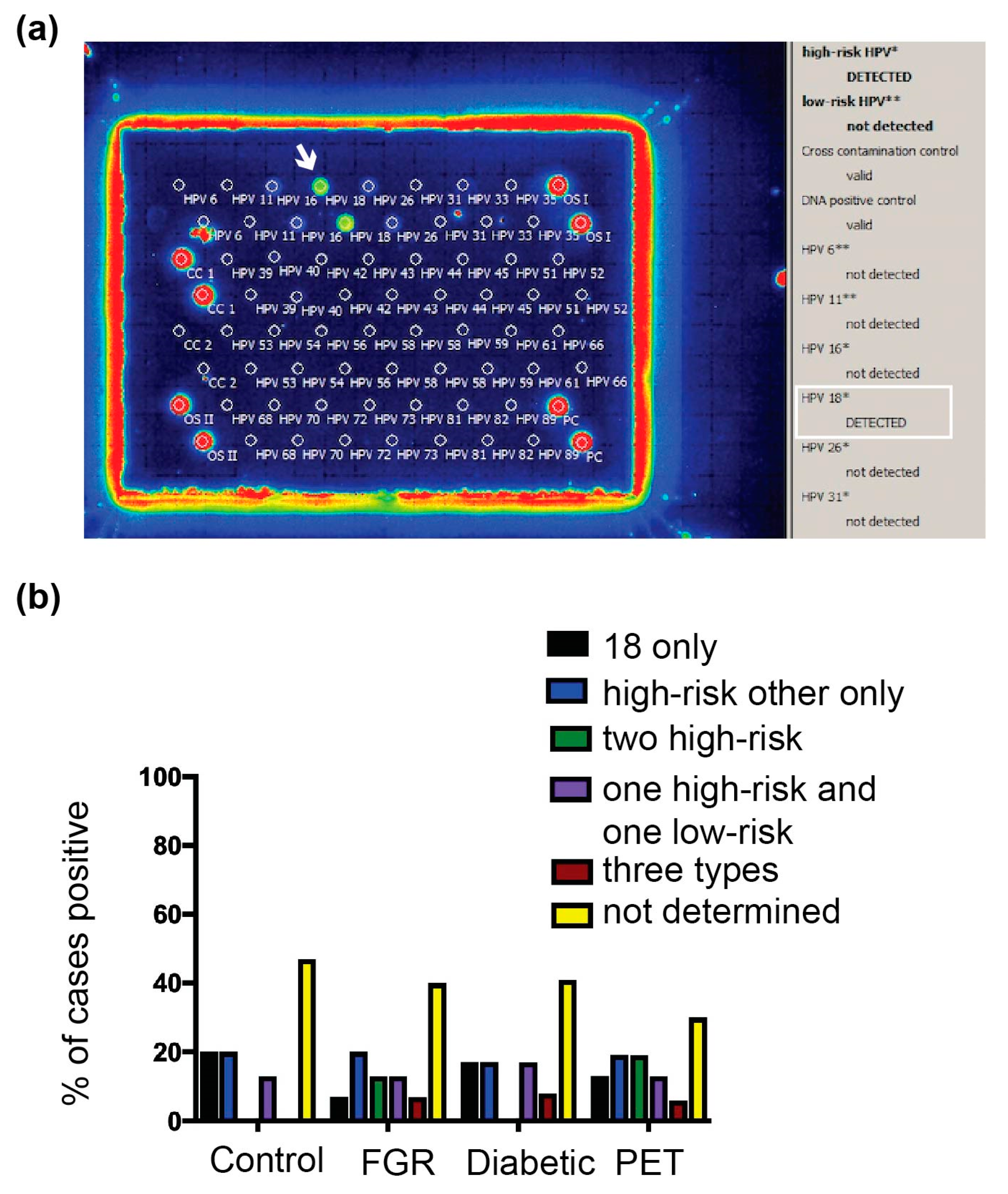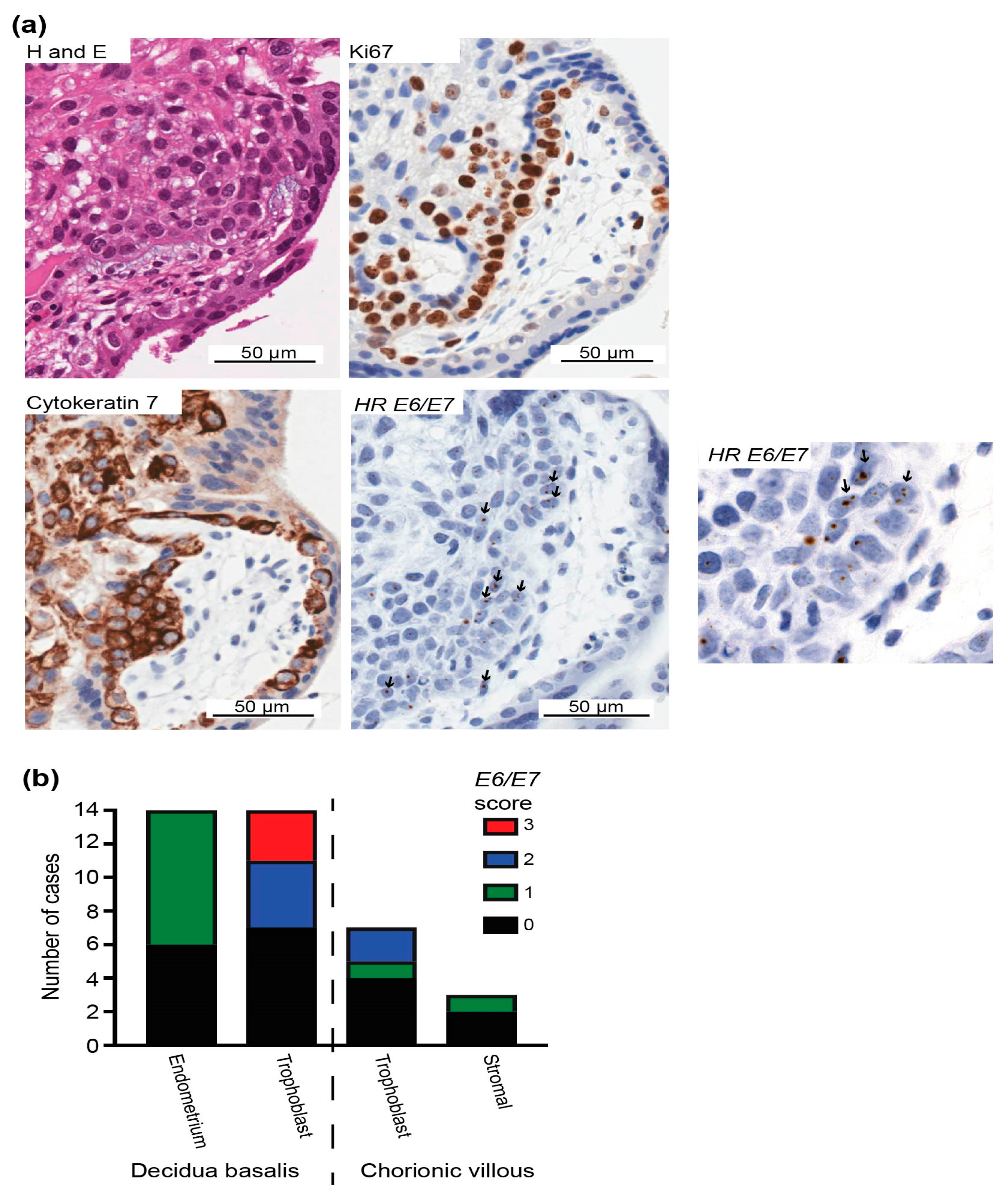Human Papillomavirus E6/E7 Expression in Preeclampsia-Affected Placentae
Abstract
1. Introduction
2. Results
2.1. High-Risk E6/E7 in Placentae from PET-Complicated Pregnancies
2.2. Analysis of E6/E7 Expression with Low-Risk HPV
2.3. HPV Types in the PET Placenta
2.4. HPV E6/E7 was Present in First-Trimester Placentae
3. Discussion
4. Materials and Methods
4.1. Sample Collection
4.2. HPV DNA in situ Hybridization
4.3. HPV Typing
4.4. RNAscope
4.5. Slide Analysis
4.6. Immunohistochemistry
4.7. Statistical Analyses
5. Conclusions
Supplementary Materials
Author Contributions
Funding
Acknowledgments
Conflicts of Interest
References
- McQuillan, G.; Kruszon-Moran, D.; Markowitz, L.E.; Unger, E.R.; Paulose-Ram, R. Prevalence of HPV in Adults Aged 18-69: United States, 2011–2014; NCHS Data Brief; National Center for Health Statistics, Centers for Disease Control and Prevention: Hyattsville, MD, USA, 2017; Volume 280, pp. 1–8.
- Liu, P.; Xu, L.; Sun, Y.; Wang, Z. The prevalence and risk of human papillomavirus infection in pregnant women. Epidemiol. Infect. 2014, 142, 1567–1578. [Google Scholar] [CrossRef] [PubMed]
- Ford, J.H.; Li, M.; Scheil, W.; Roder, D. Human papillomavirus infection and intrauterine growth restriction: A data-linkage study. J. Matern. Fetal Neonatal Med. 2017, 1–7. [Google Scholar] [CrossRef] [PubMed]
- Zuo, Z.; Goel, S.; Carter, J.E. Association of cervical cytology and HPV DNA status during pregnancy with placental abnormalities and preterm birth. Am. J. Clin. Pathol. 2011, 136, 260–265. [Google Scholar] [CrossRef] [PubMed]
- McDonnold, M.; Dunn, H.; Hester, A.; Pacheco, L.D.; Hankins, G.D.; Saade, G.R.; Costantine, M.M. High risk human papillomavirus at entry to prenatal care and risk of preeclampsia. Am. J. Obstet. Gynecol. 2014, 210, 138. [Google Scholar] [CrossRef] [PubMed]
- Slatter, T.L.; Hung, N.G.; Clow, W.M.; Royds, J.A.; Devenish, C.J.; Hung, N.A. A clinicopathological study of episomal papillomavirus infection of the human placenta and pregnancy complications. Mod. Pathol. 2015, 28, 1369–1382. [Google Scholar] [CrossRef] [PubMed]
- Bilyk, O.O.; Pande, N.T.; Pejovic, T.; Buchinska, L.G. The frequency of human papilloma virus types 16, 18 in upper genital tract of women at high risk of developing ovarian cancer. Exp. Oncol. 2014, 36, 121–124. [Google Scholar]
- Gomez, L.M.; Ma, Y.; Ho, C.; McGrath, C.M.; Nelson, D.B.; Parry, S. Placental infection with human papillomavirus is associated with spontaneous preterm delivery. Hum. Reprod. 2008, 23, 709–715. [Google Scholar] [CrossRef]
- Hermonat, P.L.; Kechelava, S.; Lowery, C.L.; Korourian, S. Trophoblasts are the preferential target for human papilloma virus infection in spontaneously aborted products of conception. Hum. Pathol. 1998, 29, 170–174. [Google Scholar] [CrossRef]
- Armbruster-Moraes, E.; Ioshimoto, L.M.; Leao, E.; Zugaib, M. Detection of human papillomavirus deoxyribonucleic acid sequences in amniotic fluid during different periods of pregnancy. Am. J. Obstet. Gynecol. 1993, 169, 1074. [Google Scholar] [CrossRef]
- Eppel, W.; Worda, C.; Frigo, P.; Ulm, M.; Kucera, E.; Czerwenka, K. Human papillomavirus in the cervix and placenta. Obstet. Gynecol. 2000, 96, 337–341. [Google Scholar] [PubMed]
- Weyn, C.; Thomas, D.; Jani, J.; Guizani, M.; Donner, C.; Van Rysselberge, M.; Hans, C.; Bossens, M.; Englert, Y.; Fontaine, V. Evidence of human papillomavirus in the placenta. J. Infect. Dis. 2011, 203, 341–343. [Google Scholar] [CrossRef] [PubMed]
- Hermonat, P.L.; Han, L.; Wendel, P.J.; Quirk, J.G.; Stern, S.; Lowery, C.L.; Rechtin, T.M. Human papillomavirus is more prevalent in first trimester spontaneously aborted products of conception compared to elective specimens. Virus Genes 1997, 14, 13–17. [Google Scholar]
- Cho, G.; Min, K.J.; Hong, H.R.; Kim, S.; Hong, J.H.; Lee, J.K.; Oh, M.J.; Kim, H. High-risk human papillomavirus infection is associated with premature rupture of membranes. BMC Pregnancy Childbirth 2013, 13, 173. [Google Scholar] [CrossRef] [PubMed]
- Bober, L.; Guzowski, G.; Moczulska, H.; Sieroszewski, P. Influence of Human Papilloma Virus (HPV) infection on early pregnancy. Ginekol. Pol. 2019, 90, 72–75. [Google Scholar] [CrossRef]
- Caballero, A.; Dudley, D.; Ferguson, J.; Pettit, K.; Boyle, A. Maternal Human Papillomavirus and Preterm Premature Rupture of Membranes: A Retrospective Cohort Study. J. Women’s Health 2019, 28, 606–611. [Google Scholar] [CrossRef] [PubMed]
- Ambuhl, L.M.M.; Villadsen, A.B.; Baandrup, U.; Dybkaer, K.; Sorensen, S. HPV16 E6 and E7 Upregulate Interferon-Induced Antiviral Response Genes ISG15 and IFIT1 in Human Trophoblast Cells. Pathogens 2017, 6, 40. [Google Scholar] [CrossRef] [PubMed]
- Bodily, J.; Laimins, L.A. Persistence of human papillomavirus infection: Keys to malignant progression. Trends Microbiol. 2011, 19, 33–39. [Google Scholar] [CrossRef] [PubMed]
- Boulenouar, S.; Weyn, C.; Van Noppen, M.; Moussa Ali, M.; Favre, M.; Delvenne, P.O.; Bex, F.; Noel, A.; Englert, Y.; Fontaine, V. Effects of HPV-16 E5, E6 and E7 proteins on survival, adhesion, migration and invasion of trophoblastic cells. Carcinogenesis 2010, 31, 473–480. [Google Scholar] [CrossRef]
- You, H.; Liu, Y.; Carey, M.J.; Lowery, C.L.; Hermonat, P.L. Defective 3A trophoblast-endometrial cell adhesion and altered 3A growth and survival by human papillomavirus type 16 oncogenes. Mol. Cancer Res. 2002, 1, 25–31. [Google Scholar]
- Ambuhl, L.M.; Baandrup, U.; Dybkaer, K.; Blaakaer, J.; Uldbjerg, N.; Sorensen, S. Human Papillomavirus Infection as a Possible Cause of Spontaneous Abortion and Spontaneous Preterm Delivery. Infect. Dis. Obstet. Gynecol. 2016, 2016, 3086036. [Google Scholar] [CrossRef] [PubMed]
- Cindrova-Davies, T.; Yung, H.W.; Johns, J.; Spasic-Boskovic, O.; Korolchuk, S.; Jauniaux, E.; Burton, G.J.; Charnock-Jones, D.S. Oxidative stress, gene expression, and protein changes induced in the human placenta during labor. Am. J. Pathol. 2007, 171, 1168–1179. [Google Scholar] [CrossRef] [PubMed]
- Martin, N.M.; Cooke, K.M.; Radford, C.C.; Perley, L.E.; Silasi, M.; Flannery, C.A. Time course analysis of RNA quality in placenta preserved by RNAlater or flash freezing. Am. J. Reprod. Immunol. 2017, 77. [Google Scholar] [CrossRef] [PubMed]
- Fajardy, I.; Moitrot, E.; Vambergue, A.; Vandersippe-Millot, M.; Deruelle, P.; Rousseaux, J. Time course analysis of RNA stability in human placenta. BMC Mol. Biol. 2009, 10. [Google Scholar] [CrossRef]
- Crook, T.; Tidy, J.A.; Vousden, K.H. Degradation of p53 can be targeted by HPV E6 sequences distinct from those required for p53 binding and trans-activation. Cell 1991, 67, 547–556. [Google Scholar] [CrossRef]
- Koskimaa, H.M.; Paaso, A.; Welters, M.J.P.; Grenman, S.; Syrjanen, K.; van der Burg, S.H.; Syrjanen, S. The presence of human papillomavirus (HPV) in placenta and/or cord blood might result in Th2 polarization. Eur. J. Clin. Microbiol. Infect. Dis. 2017, 36, 1491–1503. [Google Scholar] [CrossRef]
- Brianti, P.; De Flammineis, E.; Mercuri, S.R. Review of HPV-related diseases and cancers. New Microbiol. 2017, 40, 80–85. [Google Scholar]
- Boulet, G.A.; Micalessi, I.M.; Horvath, C.A.; Benoy, I.H.; Depuydt, C.E.; Bogers, J.J. Nucleic acid sequence-based amplification assay for human papillomavirus mRNA detection and typing: Evidence for DNA amplification. J. Clin. Microbiol. 2010, 48, 2524–2529. [Google Scholar] [CrossRef]
- Addison, D.; Seidelmann, S.B.; Janjua, S.A.; Emami, H.; Staziaki, P.V.; Hallett, T.R.; Szilveszter, B.; Lu, M.T.; Cambria, R.P.; Hoffmann, U.; et al. Human Papillomavirus Status and the Risk of Cerebrovascular Events Following Radiation Therapy for Head and Neck Cancer. J. Am. Heart Assoc. 2017, 6. [Google Scholar] [CrossRef]
- Kuo, H.K.; Fujise, K. Human Papillomavirus and Cardiovascular Disease Among U.S. Women in the National Health and Nutrition Examination Survey, 2003 to 2006. J. Am. Coll. Cardiol. 2011, 58, 2001–2006. [Google Scholar] [CrossRef]
- Joo, E.J.; Chang, Y.; Kwon, M.J.; Cho, A.; Cheong, H.S.; Ryu, S. High-Risk Human Papillomavirus Infection and the Risk of Cardiovascular Disease in Korean Women A Cohort Study. Circ. Res. 2019, 124, 747–756. [Google Scholar] [CrossRef] [PubMed]
- Chellappan, S.; Kraus, V.B.; Kroger, B.; Munger, K.; Howley, P.M.; Phelps, W.C.; Nevins, J.R. Adenovirus E1A, simian virus 40 tumor antigen, and human papillomavirus E7 protein share the capacity to disrupt the interaction between transcription factor E2F and the retinoblastoma gene product. Proc. Natl. Acad. Sci. USA 1992, 89, 4549–4553. [Google Scholar] [CrossRef] [PubMed]
- You, H.; Liu, Y.; Agrawal, N.; Prasad, C.K.; Edwards, J.L.; Osborne, A.F.; Korourian, S.; Lowery, C.L.; Hermonat, P.L. Multiple human papillomavirus types replicate in 3A trophoblasts. Placenta 2008, 29, 30–38. [Google Scholar] [CrossRef] [PubMed]
- You, H.; Liu, Y.; Agrawal, N.; Prasad, C.K.; Chiriva-Internati, M.; Lowery, C.L.; Kay, H.H.; Hermonat, P.L. Infection, replication, and cytopathology of human papillomavirus type 31 in trophoblasts. Virology 2003, 316, 281–289. [Google Scholar] [CrossRef] [PubMed]
- Germain, A.M.; Carvajal, J.; Sanchez, M.; Valenzuela, G.J.; Tsunekawa, H.; Chuaqui, B. Preterm labor: Placental pathology and clinical correlation. Obstet. Gynecol. 1999, 94, 284–289. [Google Scholar] [CrossRef] [PubMed]
- Nimrodi, M.; Kleitman, V.; Wainstock, T.; Gemer, O.; Meirovitz, M.; Maymon, E.; Benshalom-Tirosh, N.; Erez, O. The association between cervical inflammation and histologic evidence of HPV in PAP smears and adverse pregnancy outcome in low risk population. Eur. J. Obstet. Gynecol. Reprod. Biol. 2018, 225, 160–165. [Google Scholar] [CrossRef]
- Thomas, J.T.; Hubert, W.G.; Ruesch, M.N.; Laimins, L.A. Human papillomavirus type 31 oncoproteins E6 and E7 are required for the maintenance of episomes during the viral life cycle in normal human keratinocytes. Proc. Natl. Acad. Sci. USA 1999, 96, 8449–8454. [Google Scholar] [CrossRef]
- Park, R.B.; Androphy, E.J. Genetic analysis of high-risk E6 in episomal maintenance of human papillomavirus genomes in primary human keratinocytes. J. Virol. 2002, 76, 11359–11364. [Google Scholar] [CrossRef]
- Ronco, L.V.; Karpova, A.Y.; Vidal, M.; Howley, P.M. Human papillomavirus 16 E6 oncoprotein binds to interferon regulatory factor-3 and inhibits its transcriptional activity. Gene Dev. 1998, 12, 2061–2072. [Google Scholar] [CrossRef]
- Molden, T.; Kraus, I.; Karlsen, F.; Skomedal, H.; Hagmar, B. Human papillomavirus E6/E7 mRNA expression in women younger than 30 years of age. Gynecol. Oncol. 2006, 100, 95–100. [Google Scholar] [CrossRef]
- Molden, T.; Kraus, I.; Karlsen, F.; Skomedal, H.; Nygard, J.F.; Hagmar, B. Comparison of human papillomavirus messenger RNA and DNA detection: A cross-sectional study of 4,136 women >30 years of age with a 2-year follow-up of high-grade squamous intraepithelial lesion. Cancer Epidemiol. Biomark. Prev. 2005, 14, 367–372. [Google Scholar] [CrossRef] [PubMed]
- Hong, D.; Liu, J.; Hu, Y.; Lu, X.N.; Li, B.H.; Li, Y.; Hu, D.X.; Lu, W.G.; Xie, X.; Cheng, X.D. Viral E6 is overexpressed via high viral load in invasive cervical cancer with episomal HPV16. BMC Cancer 2017, 17. [Google Scholar] [CrossRef] [PubMed]
- Guidry, J.T.; Scott, R.S. The interaction between human papillomavirus and other viruses. Virus Res. 2017, 231, 139–147. [Google Scholar] [CrossRef] [PubMed]
- Oh, S.T.; Longworth, M.S.; Laimins, L.A. Roles of the E6 and E7 proteins in the life cycle of low-risk human papillomavirus type 11. J. Virol. 2004, 78, 2620–2626. [Google Scholar] [CrossRef]
- Drews, C.M.; Case, S.; Vande Pol, S.B. E6 proteins from high-risk HPV, low-risk HPV, and animal papillomaviruses activate the Wnt/-catenin pathway through E6AP-dependent degradation of NHERF1. PLoS Pathog. 2019, 15, e1007575. [Google Scholar] [CrossRef]
- Dickson, E.L.; Vogel, R.I.; Bliss, R.L.; Downs, L.S. Multiple-Type Human Papillomavirus (HPV) Infections A Cross-Sectional Analysis of the Prevalence of Specific Types in 309,000 Women Referred for HPV Testing at the Time of Cervical Cytology. Int. J. Gynecol. Cancer 2013, 23, 1295–1302. [Google Scholar] [CrossRef]
- Chaturvedi, A.K.; Katki, H.A.; Hildesheim, A.; Rodriguez, A.C.; Quint, W.; Schiffman, M.; Van Doorn, L.J.; Porras, C.; Wacholder, S.; Gonzalez, P.; et al. Human Papillomavirus Infection with Multiple Types: Pattern of Coinfection and Risk of Cervical Disease. J. Infect. Dis. 2011, 203, 910–920. [Google Scholar] [CrossRef]
- Bellamy, L.; Casas, J.P.; Hingorani, A.D.; Williams, D.J. Pre-eclampsia and risk of cardiovascular disease and cancer in later life: Systematic review and meta-analysis. BMJ Br. Med. J. 2007, 335, 974–977. [Google Scholar] [CrossRef]
- Davis, E.F.; Lazdam, M.; Lewandowski, A.J.; Worton, S.A.; Kelly, B.; Kenworthy, Y.; Adwani, S.; Wilkinson, A.R.; McCormick, K.; Sargent, I.; et al. Cardiovascular Risk Factors in Children and Young Adults Born to Preeclamptic Pregnancies: A Systematic Review. Pediatrics 2012, 129, E1552–E1561. [Google Scholar] [CrossRef]
- Watanabe, K.; Matsubara, K.; Nakamoto, O.; Ushijima, J.; Ohkuchi, A.; Koide, K.; Makino, S.; Mimura, K.; Morikawa, M.; Naruse, K.; et al. Outline of the new definition and classification of "Hypertensive Disorders of Pregnancy (HDP)"; a revised JSSHP statement of 2005. Hypertens Res. Pregna 2018, 6, 33–37. [Google Scholar] [CrossRef]






| New Zealand PET | New Zealand HR HPV Control | New Zealand FGR | New Zealand Diabetic | New Zealand HPV Negative | Japan HDP | Japan Control | |
|---|---|---|---|---|---|---|---|
| (n = 18) | (n = 15) | (n = 15) | (n = 12) | (n = 10) | (n = 15) | (n = 11) | |
| Maternal age (years) | 28.3 (5.8) | 32.5 (7.2) | 31.7 (2.7) | 31.9 (5) | 30.6 (9.3) | 36.1 (4.4) | 35 (6.2) |
| Delivery method | |||||||
| Emergency C section | 39% | 20% | 13% | 8% | 0% | 47% | 0% |
| Elective C section | 11% | 33% | 47% | 59% | 20% | 33% | 9% |
| Vaginal | 50% | 47% | 40% | 33% | 80% | 20% a | 91% |
| BMI | 27.7 (6.3) | 25.8 (5.7) | 27 (6.6) | 29 (6.1) | 23.4 (4.6) | 23.4 (4.6) | 21.5 (4.8) |
| Smoking | 11% | 27% | 27% | 25% | 20% | 7% | 0% |
| Gravida | 2 (1–4) | 2 (1–4) | 2.5 (1–4.25) | 1.5 (1–3) | 2 (0–2) | 2 (0–2) | 1 (0–1) |
| Parity | 1 (0–1) | 1 (0–1) | 1 (0–2.5) | 0.5 (0–1.75) | 1 (0–2) | 1 (0–2) | 0 (0–1) |
| Miscarriage | 0 (0–0) | 0 (0–0) | 0 (0–0) | 0 (0–0.75) | 0 (0–1) | 0 (0–1) | 0 (0–1) |
| Baby sex (% female) | 55% | 67% | 40% | 42% | 50% | 35% | 64% |
| Gestation weeks | 36.2 (3.4) | 37.6 (3) | 36.6 (2.8) | 36.9 (1.9) | 38.9 (1.8) | 36.6 (1.7) | 39.2 (1.3) |
| Fetal growth measurement 1 | 28.1 (27.8) | 38.4 (28.7) | 8.48 (14.9) | 72.4 (35.7) | 32.1 (28.3) | −0.97 (1.4) | −0.32 (0.52) |
| High-risk HPV positive | 89% 2 (n = 16) | 100% 3 (n = 15) | 100% 3 (n = 15) | 100% 3 (n = 12) | 0% 3 (n = 0) | 47% (n = 7) | 9% (n = 1) |
| Cohort | PET (n = 18) | HR HPV Control (n = 15) | FGR (n = 15) | Diabetic (n = 12) |
|---|---|---|---|---|
| High-risk HPV DNA positive | 89% (n = 16/18) | 100% (n = 15/15) | 100% (n = 15/15) | 100% (n = 12/12) |
| High-risk E6/E7/ high-risk HPV DNA positive | 81% 1 (n = 13/16) | 13% (n = 2/15) | 40% (n = 6/15) | 25% (n = 3/12) |
| Low-risk E6/E7 positive | 28% (n = 5/18) | 7% (n = 1/15) | - | - |
| High- and low-risk E6/E7 positive | 28% (n = 5/18) | - | - | - |
| HDP (n = 15) | Control (n = 11) | |
|---|---|---|
| High-risk HPV DNA positive | 47% (n = 7/15) | 9% (n = 1/11) |
| High-risk E6/E7/high-risk HPV DNA positive | 86% 1 (n = 6/7) | 0% (n = 0/1) |
| Low-risk E6/E7 positive | 33% 2 (n = 5/15) | 0% |
| High- and low-risk E6/E7 positive | 13% (n = 2/15) | 0% |
| Decidua Basalis: Endometrial Epithelium | Decidua Basalis: Stromal Cells/Trophoblast | Chorionic Villi: Trophoblast | Chorionic Villi: Stromal Cells | |
|---|---|---|---|---|
| High-risk HPV DNA positive | 44% (n = 14/32) | 38% (n = 12/32) | 22% (n = 7/32) | 9% (n = 3/32) |
| High-risk E6/E7 RNA positive | 25% (n = 8/32) | 22% (n = 7/32) | 9% (n = 3/32) | 3% (n = 1/32) |
| High-risk E6/E7 RNA/HPV high-risk DNA positive | 57% (n = 8/14) | 58% (n = 7/12) | 43% (n = 3/7) | 33% (n = 1/3) |
© 2020 by the authors. Licensee MDPI, Basel, Switzerland. This article is an open access article distributed under the terms and conditions of the Creative Commons Attribution (CC BY) license (http://creativecommons.org/licenses/by/4.0/).
Share and Cite
Reily-Bell, A.L.; Fisher, A.; Harrison, B.; Bowie, S.; Ray, S.; Hawkes, M.; Wise, L.M.; Fukuzawa, R.; Macaulay, E.C.; Devenish, C.J.; et al. Human Papillomavirus E6/E7 Expression in Preeclampsia-Affected Placentae. Pathogens 2020, 9, 239. https://doi.org/10.3390/pathogens9030239
Reily-Bell AL, Fisher A, Harrison B, Bowie S, Ray S, Hawkes M, Wise LM, Fukuzawa R, Macaulay EC, Devenish CJ, et al. Human Papillomavirus E6/E7 Expression in Preeclampsia-Affected Placentae. Pathogens. 2020; 9(3):239. https://doi.org/10.3390/pathogens9030239
Chicago/Turabian StyleReily-Bell, Ashley L., Amanda Fisher, Bryony Harrison, Sara Bowie, Sankalita Ray, Mary Hawkes, Lyn M. Wise, Ryuji Fukuzawa, Erin C. Macaulay, Celia J. Devenish, and et al. 2020. "Human Papillomavirus E6/E7 Expression in Preeclampsia-Affected Placentae" Pathogens 9, no. 3: 239. https://doi.org/10.3390/pathogens9030239
APA StyleReily-Bell, A. L., Fisher, A., Harrison, B., Bowie, S., Ray, S., Hawkes, M., Wise, L. M., Fukuzawa, R., Macaulay, E. C., Devenish, C. J., Hung, N. A., & Slatter, T. L. (2020). Human Papillomavirus E6/E7 Expression in Preeclampsia-Affected Placentae. Pathogens, 9(3), 239. https://doi.org/10.3390/pathogens9030239





